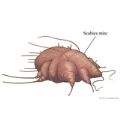Scabies
Topic Overview
What is scabies?
Scabies is a condition of very itchy skin caused by tiny mites that burrow into your skin. The itching is caused by an allergic reaction to the mites.
Scabies spreads very easily from person to person. It can affect people of all ages and from all incomes, social levels, and living situations.
With treatment, the scabies mites die and the itching goes away over a period of days to weeks. Without treatment, the mites continue to reproduce under the skin, causing more sores and itching.
How is scabies spread?
Scabies mites spread from person to person by close contact, such as sleeping in the same bed or touching someone’s skin. The mites can also be spread by sharing towels, clothing, and other personal items.
Scabies often affects several household members at the same time. You can spread it to another person before you have symptoms.
What are the symptoms?
Scabies has two main symptoms:
- Severe itching that is usually worse at night. Small children and older adults tend to have the worst itching.
- A rash with tiny blisters or sores. Children tend to have worse skin reactions than adults.
Symptoms are more likely to occur:
- Between the fingers and on the palm side of the wrists.
- On the outside surfaces of the elbows and in the armpits.
- Around the waistline and navel.
- On the buttocks.
- Around the nipples, the bra line, and the sides of the breasts (in women).
- On the genitals (in men).
In babies and small children, itching and skin irritation may also occur on the scalp, neck, and face and on the palms of the hands and soles of the feet.
If you have many scaly, crusted sores, you may have a rare form of scabies called crusted scabies or Norwegian scabies.
If this is the first time you have had scabies, it may be several weeks before you have itching and skin sores. But if you have had it before, symptoms will probably start in a few days.
How is scabies diagnosed?
Usually a doctor can diagnose scabies based on your symptoms. Scabies is especially likely if you have had close contact with other people who have had the same symptoms.
Sometimes you may have a test to confirm that you have scabies. For example, the doctor may gently scrape some dry skin from an affected area and look at it under a microscope for signs of mites.
How is it treated?
Scabies won’t go away on its own. To get rid of it, and to keep from spreading it to others, you need to use a special cream or lotion that a doctor prescribes. These products contain permethrin or another medicine. In severe cases, your doctor may also give you pills to take.
Most creams or lotions are applied to the entire body from the neck down. In most cases, you leave the medicine on for 8 to 14 hours and then wash it off. Be sure to read and follow all instructions that come with your medicine.
Children can usually return to day care or school after treatment is completed.
Some scabies medicines aren’t safe for children, older adults, and women who are pregnant or breastfeeding. To avoid dangerous side effects, be sure to follow your doctor’s instructions carefully.
If you have scabies, you and anyone you have close contact with must all be treated at the same time. This keeps the mites from being passed back and forth from person to person. Until scabies has cleared up, you should avoid close contact with anyone and make sure not to share any personal items.
To make sure that all the mites are killed:
- Wash all clothes, bedding, and towels that you used in the 3 days before you started treatment. Use hot water, and use the hot cycle in a dryer. Another option is to dry-clean these items. Or seal them in a plastic bag for 3 to 7 days.
- Clean and carefully vacuum the room or rooms used by the person who had scabies.
After treatment, the itching usually lasts another 2 to 4 weeks. It will take your body that long to get over the allergic reaction caused by the mites. Antihistamines include a nondrowsy one like loratadine (Claritin) or one that might make you sleepy like diphenhydramine (Benadryl). Other medicine, like steroid creams, or, in severe cases, steroid pills can help relieve itching. Before you use these medicines, talk with your doctor about what is best for you (or your child).
If you still have symptoms after 4 weeks, you may need another treatment.
References
Other Works Consulted
- Tucker WFG (2010). Scabies. In MG Lebwohl et al., eds., Treatment of Skin Disease: Comprehensive Therapeutic Strategies, 3rd ed., pp. 682–684. Philadelphia: Mosby Elsevier.
- Wolff K, Johnson RA (2009). Scabies. In Fitzpatrick’s Color Atlas and Synopsis of Clinical Dermatology, 6th ed., pp. 868–876. New York: McGraw-Hill.
Current as of: April 1, 2019
Author: Healthwise Staff
Medical Review:Adam Husney, MD – Family Medicine & Martin J. Gabica, MD – Family Medicine & E. Gregory Thompson, MD – Internal Medicine
Topic Contents
This information does not replace the advice of a doctor. Healthwise, Incorporated, disclaims any warranty or liability for your use of this information. Your use of this information means that you agree to the Terms of Use. Learn how we develop our content.



